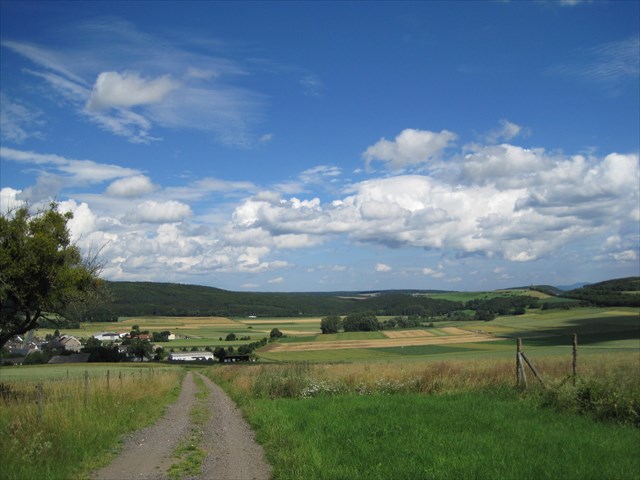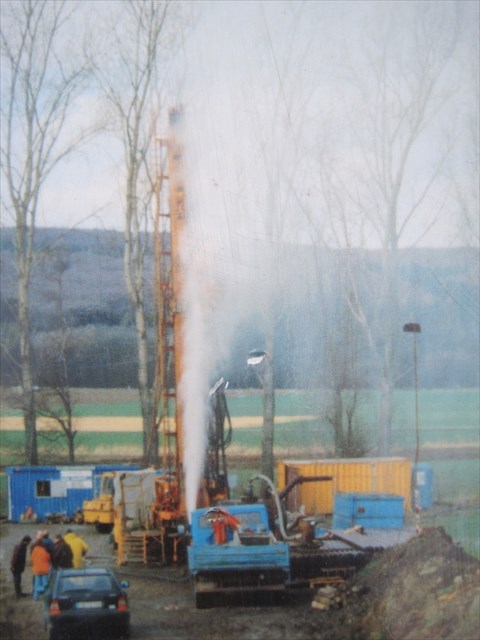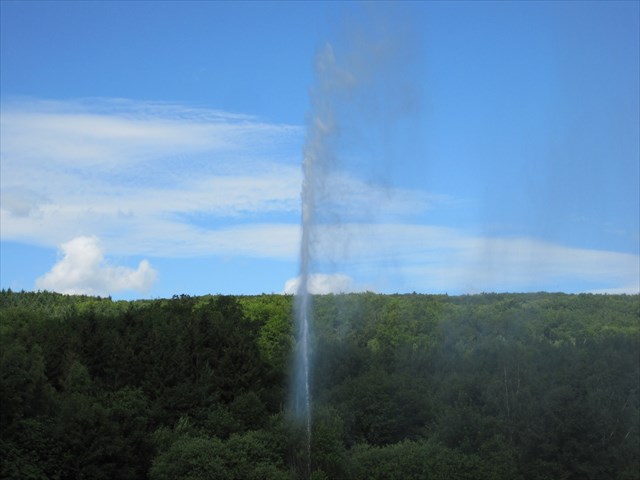Der Wehrer Kessel ist eine Caldera, die durch eingestürzte Hohlräume bei der Förderung von Tuffen aus einem in der Erdkruste gelegenen Herd entstanden ist. Die Maße in der Längsachse in SE-NW-Richtung, betragen ca. 2.000 m. In der Breite betragen die Maße ca. 1750 m.

Die Ausbrüche des Wehrer Vulkans erfolgten in mehreren Phasen: Vor etwa 300.000 Jahren wurden die Ablagerungen des Riedener Vulkans im einstigen oberen Wirrbachtal von Basaltmagma durchbrochen. Dieses baute den Tiefenstein und den Meirother Kopf auf. Bedingt durch das Leeren der Magmakammer brach schließlich der Kessel ein.
Vor ca. 215.000 Jahren wurde durch eine weitere Eruption des Hüttenbergs Bims und Asche ausgeworfen. Infolge bildete sich ein Tuffring. In Bohrkernen fand man Sedimente mit einer Mächtigkeit von 10 bis 20 m, die auf die Bildung eines Sees im Zentrum des heutigen Kessels schließen lassen. Nach einer Ruhezeit von ca. 65.000 Jahren kam es dann vor ca. 151.000 Jahre zur letzten großen Eruption. Die Mächtigkeit der Ablagerungen im Kraterbereich betrug 35 bis 50 m. Bedingt durch Abtragungen der vulkanischen Lockergesteine entstand in der Folgezeit ein Kratersee. Im See lagerten sich Asche und Schwebeteilchen ab. Eine 10 bis 60 m dicke luft- und gasdichte Abdeckung entstand am Grund des See´s. Dieser See trocknete im Lauf vieler Jahre aus und bildete den Wehrer Kessel, das heutige Trockenmaar.
Durch dieses Trockenmaar wurde eine restlose Entgasung des erloschenen Vulkans verhindert und darum liegt dort:
Das größte natürliche Kohlensäurevorkommen Europas unter der Erde.
An vielen Stellen im Talkessel stehen Behälter, mit deren Hilfe das Gas aufgefangen wird. Von den Behältern wird es über Pipelines zur Sammelstation geleitet.
In den Kellern der Häuser von Wehr sammelt sich ebenfalls Kohlensäure. Weil das zur tödlichen Falle werden kann, nehmen die Wehrer stets eine Kerze mit, wenn sie in den Keller müssen. Sollte die Kerzenflamme ausgehen, hat die Kohlensäure den Sauerstoff verdrängt und das Atmen wäre unmöglich.
Eine positive Folgeerscheinung des Kohlensäureabbaus ist, das durch die Brunnenbohrungen ein weiterer Kaltwassergeysir entstand der eine Fontäne von 40 m in den Himmel springen lässt.

Über die Funktionsweise kann man sich im Geysirzentrum Andernach informieren.
Da dieser Geysir durch die ansässige Kohlensäurefirma reguliert wird kann man das Schauspiel im April - Oktober täglich kostenfrei um 11.00 und um 16.00 Uhr
und im November - März um 11.00 Uhr von der Aussichtsplattform beobachten.

Hier nun die Fragen zu diesem Earthcache, alle Antworten findet ihr an der angegebenen Koordinate :
1. Was bedeutet das Wort "Geysa" ?
2. Warum ist das natürliche Kohlensäure Rohgas aus dem Vorkommen des Wehrer Kessels industriell Interessant ?
3. Schaut euch um und nutzt euren Kompass, an welcher Stelle der Caldera befindet ihr euch ? Norden, Osten, Westen, Süden ?
4. Über ein Foto von dir / euch oder dem Geysir im Log würden wir uns sehr freuen.
Bitte schicke deine Antworten an meinen Account, sollte etwas nicht in Ordnung sein werden wir uns melden. Ihr dürft also sofort loggen.
Englisch
The "Wehrer Kessel" and its Gushing Spring
You are at the side of the caldera of the "Wehrer Kessel", from here you can see the Geysir.
The Wehrer Kessel is a caldera which arised out of collapsed underground cavities during the drivage of volcanic tuff out of a focus reclined in earth crust. The dimension of the longitudinal axis in SE-NW-direction is about 2000m. The latidude dimensions are about 1750m.

The eruptions of the Wehrer volcano occured in different phases:
300.000 years ago the accumulation of the Riedener Volcano in the former upper "Wirbachtal" was cut off by basaltmagma. This built up the “Tiefenstein” and the “Meirother Kopf”. In consequence of the flushing of the magmachamber the caldera collapsed.215.00 years ago, a phreatomagmatic eruption of the “Hüttenberg” threw pumice which lead to the building of a tuff circle. Core samples have shown sediments with a thickness of 10 to 20 meters. It can be suggested that a lake was in formation at this time.After a resting period of round about 65.000 years, 115.000 years ago one last huge eruption happened. The thickness of these sediments where between 35 to 50 meters. By degradation of the volcanic granular soil a lake occurred. In this lake a 10 to 60 meters thick dense air and gas tight layer was built up at the bottom of the lake. The lake desiccated over the years, building the “Wehrer Kessel”, today a waterless maar. A complete decarbonization was avoided by this waterless maar.
Hence at this place the largest amount of carbonic acid in whole Europe can be found.
In the whole caldera, there are tanks which should collect the gas.From this containers the gas gets transported by pipelines to a main collecting container.
In the basements of houses in Wehr, carbonic acid could also be found. Therefore the people in this village always carry a candle if they have to go down to the basement because carbonic acid can be deadly. If the candle expires it is a sign, that the carbondioxide displaced the oxygen and that breathing is impossible then.
Another positive aftereffect of the carbonic acid reduction is that because of the drilling a cold water gush spring came into existence. The spring of this gush spring is about 40m high.

If you want to learn more about the function of a gush spring you can get more informations at the Geysirzentrum Andernach.
The “Wehrer Cold Water Gush Spring” can be observed April - October at 11 a.m. and 4 p.m.
at November - March just at 11 a.m.!
Exempt from charges.

And here are the Ouestions for this Earthcache, you will find the answers at the coordinates:
1. What does the word "Geysa" mean ?
2. Why is the Carbonic acid gas out of the "Wehrer Kessel" of industrial interest ?
3. Look around and use your compass, where are you ? In the East, West, South or North of the Caldera ?
4. It would be very kind of you if you could take a picture of you or the geyser at the given coordinate and put it to your log!
Please sent your answers to my Account, if there would be something wrong, we will tell you. You can log directly.